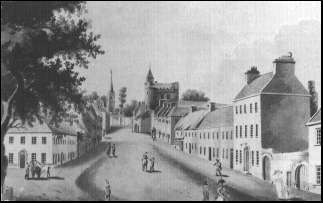
HISTORY
Kells Co. Meath is a small market town
fifty kilometers northwest of Dublin. It's situated on a ridge,
which rises about 100 meters above sea level. The river
Blackwater is to the north-east, and drains into the river Boyne.
From its earliest mention in the Annals of the Four Masters when
a dun settlement was first built here in 1207 BC, Kells has had a
long and checkered history.
It came into prominence in the early 6th century with the
building of the Columban monastery, which flourished until the 12th
century, withstanding various sackings and burning from local and
Norse raiding parties. During this period, amongst other relics,
the Great Book of Kells was completed, which is on display in
Trinity College, Dublin. A copy is on view in the New Heritage
Centre, Headford Place.
After the coming of the Anglo-Normans in the 12th century the
monastery ceased. A castle was built and over the centuries Kells
became a walled town. It was attacked and burned on numerous
occasions, either by the natives or English until it was
completely ruined in the 17th century.

Since that period the town has grown in size and statue to the
thriving market town it is today. No trace of the castle can be
found, and of the walls of the town only a small portion remains
at the back of Cannon Street, along with a mural tower.
What has survived is the buildings from the earlier
monastic city - the 100ft Round Tower, Columba`s Stone House and
the Sculptured Crosses from the 9th/10th century.
The present day Kells is a bustling modern town, richly endowed with good eating houses, quality accommodation, and wide variety in its shops and boasts over 18 public houses of good quality and quantity of alcohol beverages. Its sporting activities include golfing, fishing, tennis, horseriding, swimming etc. Cultural activities include drama and a wide variety of arts, the highlight being the Heritage Festival which this year takes place from the 30th June-8th July 2001, a week of merriment and good entertainment